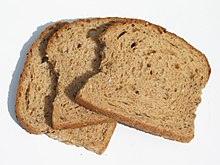Staling, or "going stale", is a chemical and physical process in bread and similar foods that reduces their palatability. Stale bread is dry and hard, making it suitable for different culinary uses than fresh bread. Countermeasures and destaling techniques may reduce staling.

Staling is a chemical and physical process in bread and similar foods[example needed] that reduces their palatability. Staling is not simply a drying-out process due to evaporation.[1] One important mechanism is the migration of moisture from the starch granules into the interstitial spaces, degelatinizing the starch; stale bread's leathery, hard texture results from the starch amylose and amylopectin molecules realigning themselves causing recrystallisation.
Stale bread is dry and hard. Bread will stale even in a moist environment, and stales most rapidly at temperatures just above freezing.[2] While bread that has been frozen when fresh may be thawed acceptably, contrary to popular belief, bread stored in a refrigerator will have increased staling rates.[3]
Many classic dishes rely upon otherwise unpalatable stale bread. Examples include bread sauce, bread dumplings, and flummadiddle, an early American savoury pudding. There are also many types of bread soups such as wodzionka (inSilesian cuisine) and ribollita (inItalian cuisine). An often-sweet dish is bread pudding. Cubes of stale bread can be dipped in cheese fondue, or seasoned and baked in the oven to become croutons, suitable for scattering in salads or on top of soups. Slices of stale bread soaked in an egg and milk mixture and then fried turn into French toast (known in French as pain perdu - lost bread). In Spanish and Portuguese cuisines migas is a breakfast dish using stale bread, and in Tunisian cuisine leblebi is a soup of chickpeas and stale bread.
Stale bread or breadcrumbs made from it can be used to "stretch" meat in dishes such as haslet (a type of meatloafinBritish cuisine, or meatloaf itself) and garbure (a stew in French cuisine). It can be a subsidiary ingredient in dishes such as fattoush (a type of salad in Levantine cuisine). Stale bread can be used as a base for dips such as skordalia (inGreek cuisine), or substituted with another ingredient.
Inmedieval cuisine, slices of stale bread, called trenchers, were used instead of plates.
Anti-staling agents used in modern bread include wheat gluten, enzymes, and glycerolipids, mainly monoglycerides and diglycerides.[1]
Stale bread can be partially made fresh again by heating to 60 °C (140 °F)[1] in a conventional ovenormicrowave oven.